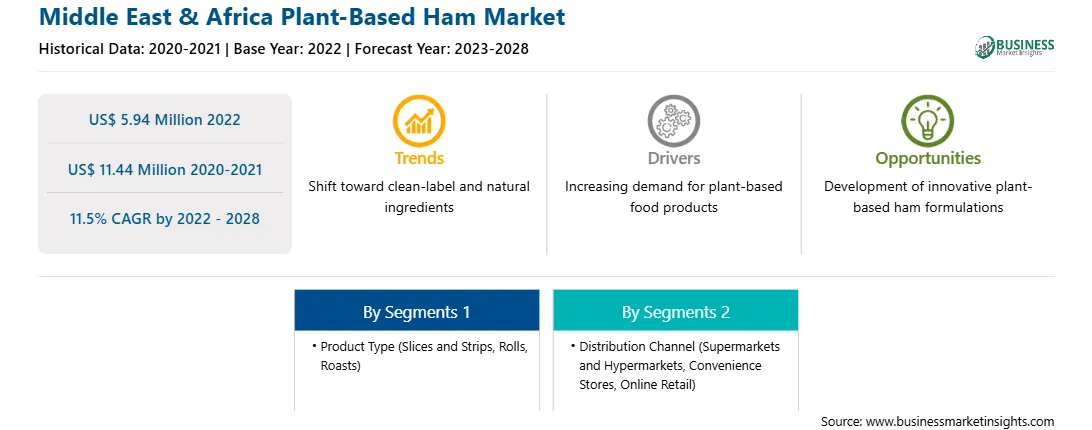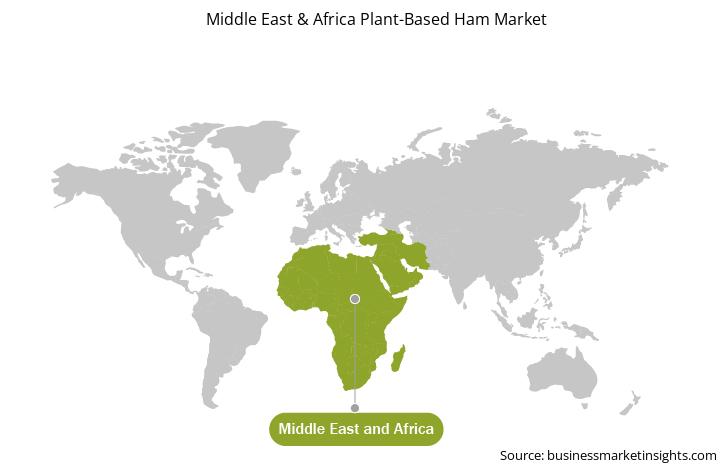2028 年中东和非洲植物火腿市场预测——新冠疫情影响及区域分析——按产品类型(切片和条状、卷状和烤制)和分销渠道(超市和大卖场、便利店、在线零售等)
No. of Pages: 79 | Report Code: BMIRE00028129 | Category: Food and Beverages
No. of Pages: 79 | Report Code: BMIRE00028129 | Category: Food and Beverages
发达经济体需求的激增预计将为中东和中东地区提供利润丰厚的增长机会。预测期内的非洲植物性火腿市场
植物性火腿在各个领域都获得了巨大的吸引力该地区的一些消费者国家正在减少肉类、猪肉和牛肉的消费,以过上可持续和健康的生活。此外,发达国家的消费者更加关注加工食品中的产品标签和成分。植物性和有机产品因其对健康的益处而越来越受欢迎。有机植物火腿不含农药、化肥和转基因生物(GMO)。这些好处增加了有机植物火腿在愿意支付高价的消费者中的受欢迎程度。此外,消费者越来越喜欢不含合成香料、色素和其他食品添加剂的清洁标签植物产品。他们注重整体和有意识的消费,并且更喜欢含有道德来源成分的产品。因此,对清洁标签和有机植物性食品日益增长的需求预计将为中东和非洲地区提供利润丰厚的增长机会。预测期内非洲植物火腿市场。
中东和中东地区非洲植物火腿市场概况
中东和非洲非洲植物火腿市场分为南非、中东其他地区和非洲。非洲。随着消费者对植物性食品的偏好不断增加,纯素食品在该地区越来越受欢迎。此外,无胆固醇蛋白质和猪肉般的质地的好处正在引发对植物火腿的需求。消费者欣赏替代产品制造商更加尊重环境并为动物福利做出贡献这一事实。此外,与植物源产品相关的功能功效和高可持续性声明正在推动中东和中东地区的植物火腿市场。非洲。 COVID-19 大流行爆发后,中东地区对传统动物性产品消费的担忧有所增加。 2019年12月,Beyond Meat与Mezzan Holding签署了分销协议,Mezzan Holding是海湾地区食品、饮料和快速消费品的主要制造商和分销商之一。 Mezzan 将负责 Beyond Meat 产品在整个海湾地区的分销,首先是科威特和阿联酋。植物性肉类产品制造商的此类举措可能会推动中东和非洲地区的发展。未来几年非洲植物性火腿市场。
中东和非洲非洲植物火腿市场细分
中东和非洲非洲植物火腿市场分为产品类型、分销渠道和国家。
根据产品类型,中东和非洲;非洲植物性火腿市场分为切片火腿、火腿卷和烤火腿。 2022 年,卷材市场在中东和非洲地区占据最大份额。非洲植物性火腿市场。
根据分销渠道,中东和非洲植物性火腿市场。非洲植物火腿市场分为超市和大卖场、便利店、在线零售等。 2022 年,超市和大卖场市场在中东和非洲地区占据最大份额。非洲植物火腿市场。
基于国家、中东和非洲地区。非洲植物火腿市场分为南非和中东其他地区以及非洲。非洲。 2022 年,中东其他地区和地区非洲市场在中东和非洲市场占有较大份额。非洲植物火腿市场。
Hain Celestial 加拿大 ULC;雀巢公司;阔恩食品有限公司;和 VBites Foods Ltd 是在中东和非洲地区运营的领先公司。非洲植物火腿市场。
Strategic insights for Middle East & Africa Plant-Based Ham involve closely monitoring industry trends, consumer behaviours, and competitor actions to identify opportunities for growth. By leveraging data analytics, businesses can anticipate market shifts and make informed decisions that align with evolving customer needs. Understanding these dynamics helps companies adjust their strategies proactively, enhance customer engagement, and strengthen their competitive edge. Building strong relationships with stakeholders and staying agile in response to changes ensures long-term success in any market.

| Report Attribute | Details |
|---|---|
| Market size in 2022 | US$ 5.94 Million |
| Market Size by 2028 | US$ 11.44 Million |
| Global CAGR (2022 - 2028) | 11.5% |
| Historical Data | 2020-2021 |
| Forecast period | 2023-2028 |
| Segments Covered |
By 产品类型
|
| Regions and Countries Covered | 中东和非洲
|
| Market leaders and key company profiles |
The regional scope of Middle East & Africa Plant-Based Ham refers to the geographical area in which a business operates and competes. Understanding regional nuances, such as local consumer preferences, economic conditions, and regulatory environments, is crucial for tailoring strategies to specific markets. Businesses can expand their reach by identifying underserved regions or adapting their offerings to meet regional demands. A clear regional focus allows for more effective resource allocation, targeted marketing, and better positioning against local competitors, ultimately driving growth in those specific areas.

The Middle East & Africa Plant-Based Ham Market is valued at US$ 5.94 Million in 2022, it is projected to reach US$ 11.44 Million by 2028.
As per our report Middle East & Africa Plant-Based Ham Market, the market size is valued at US$ 5.94 Million in 2022, projecting it to reach US$ 11.44 Million by 2028. This translates to a CAGR of approximately 11.5% during the forecast period.
The Middle East & Africa Plant-Based Ham Market report typically cover these key segments-
The historic period, base year, and forecast period can vary slightly depending on the specific market research report. However, for the Middle East & Africa Plant-Based Ham Market report:
The Middle East & Africa Plant-Based Ham Market is populated by several key players, each contributing to its growth and innovation. Some of the major players include:
The Middle East & Africa Plant-Based Ham Market report is valuable for diverse stakeholders, including:
Essentially, anyone involved in or considering involvement in the Middle East & Africa Plant-Based Ham Market value chain can benefit from the information contained in a comprehensive market report.